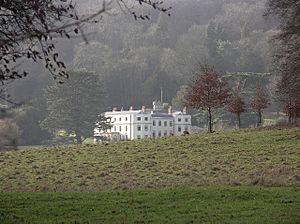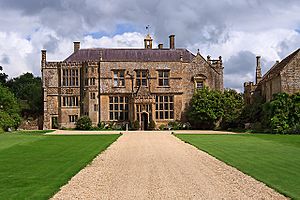Thomas Fane, 8th Earl of Westmorland facts for kids
Quick facts for kids
The Earl of Westmorland
|
|
|---|---|
 |
|
| Member of the Great Britain Parliament for Lyme Regis |
|
| In office 1753–1762 Serving with
|
|
| Preceded by |
|
| Succeeded by |
|
| Personal details | |
| Born | March 1701 |
| Died | 25 November 1771 |
| Spouse | Elizabeth Swymmer |
| Children |
|
| Parent |
|
Thomas Fane, 8th Earl of Westmorland (born March 1701, died November 25, 1771) was an important English politician and a noble. He was also an ancestor of the famous writer George Orwell.
Thomas Fane's Life Story
Thomas Fane was the second son of Henry Fane and Anne Scrope. His family lived at Brympton d'Evercy in Somerset, England. Anne Scrope was the sister of John Scrope.
Anne and John were the grandchildren of Colonel Adrian Scrope. Colonel Scrope was involved in the trial and execution of King Charles I. Thomas Fane later received a lot of money and a large house in Bristol from John Scrope. He also inherited land and property, including Wormsley Park, from Colonel Adrian Scrope.
In 1757, Thomas Fane's older brother, Francis, passed away. Thomas then inherited their father's estate at Brympton. In 1762, he became the Earl of Westmoreland. He inherited this title from John Fane, 7th Earl of Westmorland, who was his father's second-cousin and had no children. This meant Thomas also gained control of Apethorpe Hall in Northamptonshire, which was the Earls of Westmorland's main home.
Thomas Fane's Family
In 1727, Thomas Fane married Elizabeth Swymmer. Elizabeth was the daughter of William Swymmer, a sugar merchant from Bristol.
Thomas and Elizabeth had two sons and two daughters. Their children included:
- John Fane, 9th Earl of Westmorland (1728–1774)
- Henry Fane (1739–1802)
- Mary, who married Charles Blair. Charles Blair was the great-great-grandfather of Eric Arthur Blair. Eric Arthur Blair is better known by his writing name, George Orwell.
His Portrait by Joshua Reynolds
In 1761, a famous artist named Joshua Reynolds painted a full-length picture of Thomas Fane. The painting was called Mr Fane. Reynolds was paid 80 guineas for his work. A guinea was an old type of British money.
The painting shows Thomas Fane walking in a wooded area. He is wearing a rose-colored velvet suit and a powder-wig. In May 1903, the portrait was sold to Martin Colnaghi for 2,100 guineas.



